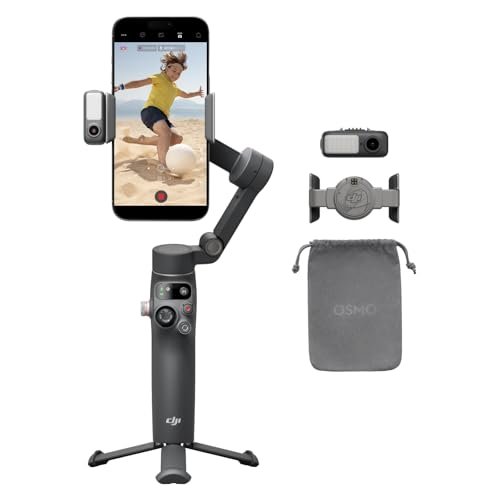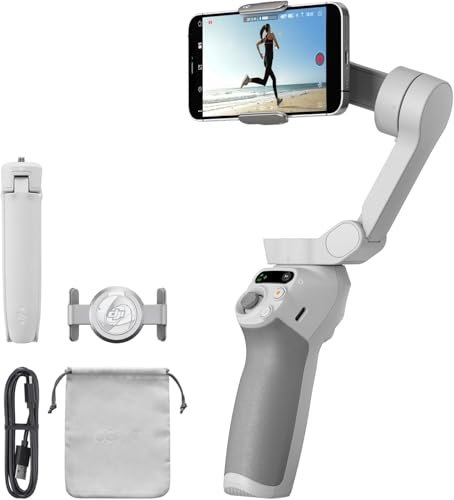Ever tried shooting a video on your iPad only to end up with shaky, wobbly footage? It’s a common struggle! While iPads are fantastic devices for capturing moments, their large size can make handheld shooting a real challenge. That’s where a gimbal for iPad comes into play. A good gimbal can transform your mobile videography, turning amateur-looking clips into smooth, cinematic masterpieces.
Gimbals, in essence, are motorized stabilizers that help keep your device level and steady, no matter how much you move. For content creators, educators, or anyone looking to improve their iPad videos, investing in the best gimbal for iPad is a game-changer. It unlocks new possibilities for dynamic shots, professional-looking vlogs, and crystal-clear video calls.
When it comes to elevating your iPad’s video capabilities, the right gear makes all the difference. While we’re focusing on tools to enhance your mobile filmmaking experience, it’s important to understand the full ecosystem of creative equipment. Sometimes, the best way to support your on-the-go creative process isn’t just a stabilizer, but also a reliable way to transport all your valuable equipment.
Gear Spotlight: Lowepro Pro Trekker BP 350 AW II Outdoor Camera Backpack

While our main focus today is on finding the best gimbal for iPad to stabilize your shots, every serious content creator knows that protecting and organizing your valuable equipment is just as crucial. The Lowepro Pro Trekker BP 350 AW II isn’t a gimbal, but it’s an indispensable piece of gear for anyone carrying an iPad, camera, lenses, and perhaps even a compact gimbal for their tablet. It stands out by offering a robust, travel-friendly solution for professional photographers and videographers who need to transport a significant amount of gear, including multiple devices like your iPad, securely and comfortably to remote locations or during travel. Its thoughtful design ensures everything stays protected and easily accessible, making it an excellent companion for any mobile filmmaking adventure.
- Travel-Friendly Design: Compact carry-on size with two grab handles, stowable harness, removable waist belt, and locking zips for easy maneuvering and security.
- MaxFit System: Patent-pending design allows for maximum gear storage, fitting a DSLR with a 70-200mm lens, 4-5 extra lenses or flashes, and multiple digital devices.
- Comprehensive Device Storage: Includes padded CradleFit pockets for a 15-inch laptop, 10-inch tablet, Wacom-type tablet, and a large smartphone.
- Comfort & Durability: Ergonomic shoulder straps, adjustable sternum, load-bearing waist belt, and a ventilated back panel ensure all-day comfort for heavy loads in challenging environments.
- Accessory Ready: Sturdy tripod straps with a SlipLock tripod cup and two zip stash pockets for quick access to travel essentials.
Pros:
– Excellent organization with dedicated padded compartments for multiple devices and camera gear.
– Extremely comfortable for carrying heavy loads over long distances.
– Durable construction suitable for outdoor and travel use.
– Carry-on friendly size, ideal for air travel.
– Provides superior protection for valuable electronics.
Cons:
– Not directly related to the function of an iPad gimbal (it carries them, but doesn’t stabilize).
– Can be considered bulky if you only need to carry a minimal setup.
– Price point might be higher than basic camera bags.
User Impressions:
Users consistently praise the Lowepro Pro Trekker BP 350 AW II for its incredible capacity and comfortable design, even when fully loaded. Many highlight its robust build quality and the peace of mind it offers when transporting expensive gear. While acknowledging it’s a backpack and not a stabilizer, mobile videographers appreciate its ability to securely hold an iPad alongside camera equipment and other filming accessories, making it a critical part of their overall production kit for on-the-go shooting.
Call-to-Action: See the Lowepro Pro Trekker BP 350 AW II on Amazon here
What to Look for in the Best Gimbal for iPad
Since our primary goal is to help you find the best gimbal for iPad stabilization, here’s a quick rundown of crucial features to consider:
- Payload Capacity: Your iPad isn’t a smartphone; it’s heavier and larger. Ensure the gimbal can comfortably support its weight and dimensions, even with a case.
- Battery Life: You don’t want your gimbal dying mid-shoot. Look for models with long battery life to keep your creative flow uninterrupted.
- Ease of Use & App Features: A user-friendly interface and a dedicated app with intelligent shooting modes (like tracking, time-lapse, panorama) can significantly enhance your experience.
- Portability: While iPads are large, a foldable or compact gimbal can still make a difference for on-the-go shooting.
- Build Quality: A durable gimbal made from quality materials will withstand regular use and protect your valuable iPad.
- Rotation & Axis: Most gimbals are 3-axis, offering excellent stabilization across tilt, roll, and pan. Ensure it offers the range of motion you need.
Frequently Asked Questions about iPad Gimbals
Q1: Why do I need a gimbal for my iPad?
A1: An iPad, while great for video, is prone to shaky footage due to its size and weight. A gimbal provides mechanical stabilization, eliminating jitters and producing smooth, professional-looking video, perfect for vlogs, interviews, or cinematic shots.
Q2: Can any phone gimbal work with an iPad?
A2: Not usually. Standard phone gimbals are designed for smaller, lighter smartphones. iPads are significantly larger and heavier, requiring a gimbal with a higher payload capacity and a wider clamp to securely hold the device. Always check the gimbal’s specifications for compatible device dimensions and weight.
Q3: Are iPad gimbals difficult to use?
A3: Most modern iPad gimbals are designed to be user-friendly. They often connect via Bluetooth to a companion app, which guides you through calibration and offers various shooting modes. With a little practice, you’ll find them intuitive to operate.
Q4: What kind of videos benefit most from an iPad gimbal?
A4: Any video where movement or stability is key! This includes vlogging, documenting travel, real estate tours, sports events, educational content, interviews, and anything where smooth camera movement enhances the storytelling.
Q5: What’s the difference between a 2-axis and a 3-axis gimbal?
A5: A 2-axis gimbal stabilizes on two axes (pitch and roll), correcting up-and-down and side-to-side movements. A 3-axis gimbal adds a third axis (pan), also correcting left-to-right rotation, providing superior, all-around stabilization for more professional results. For the best gimbal for iPad experience, a 3-axis model is generally recommended.
Q6: Do I need special apps to use an iPad gimbal?
A6: Most gimbals come with their own dedicated app that unlocks the full potential of the device, offering features like object tracking, time-lapse, hyperlapse, panorama, and fine-tuning controls. While you can often use your iPad’s native camera app, the gimbal’s companion app usually provides a richer, more integrated experience.
Q7: Can I charge my iPad while it’s on the gimbal?
A7: Some advanced gimbals offer a pass-through charging port, allowing you to power your iPad directly from the gimbal’s battery. This is a convenient feature for extended shooting sessions, especially if you’re looking for the best gimbal for iPad for long projects.
Conclusion
Transforming your iPad into a powerful mobile filmmaking tool is entirely within reach, and a high-quality stabilizer is a pivotal component. While the Lowepro Pro Trekker BP 350 AW II backpack is an excellent choice for transporting all your valuable gear – including your iPad and a potential gimbal – its function is protection and portability, not stabilization. For truly smooth, cinematic footage, the best gimbal for iPad will be a dedicated device designed to counteract camera shake. By considering the crucial features we’ve discussed, you’ll be well on your way to capturing stunning, professional-grade videos with your iPad. Happy shooting!


